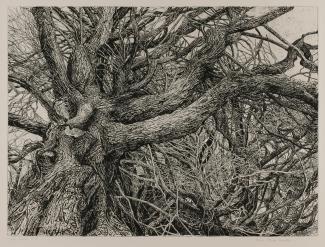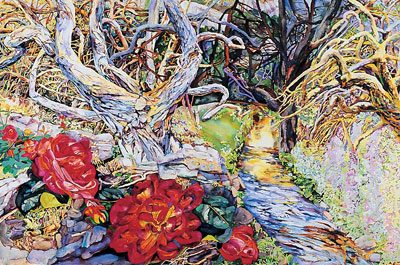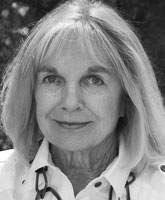Patricia Tobacco Forrester • American (1940-2014)
Rose Reprise • Watercolor on Paper 39-1/2" x 60"
Patricia Tobacco Forrester married well, but it didn’t stop her from becoming a successful artist. A farm girl from western Massachusetts, she attended college in her hometown. As luck would have it, Smith College, was known for turning out well-mannered, independent, world leaders. Think, Nancy Reagan, Barbara Bush, Betty Friedan, Gloria Steinem, Julia Child, and more. Young Patricia fit right in. She studied printmaking and sculpture with the well-known modernist, Leonard Baskin. Soon she was at Yale studying with Chuck Close and Janet Fish, two of the leading Photo-Realists of the day. She earned a prestigious Guggenheim Fellowship for Creative Arts. She was a woman on the move who fell in love with a dashing professor of psychology after discarding a first husband named Forrester. The artist and the psychiatrist settled beside the San Francisco Bay.
Her second husband, Paul Ekman, became the world’s most famous psychiatric thinker since Sigmund Freud. Unconvinced by the powers of Freud’s psychotherapy, Ekman believed facial expressions provided a truer path to a persons innermost workings. He spent years studying people in different cultures to decipher a universal language of emotions. Eventually he was named one of the “World’s 100 Most Influential People” by Time Magazine. In the meantime, his wife, Patricia Tobacco Forrester accompanied him on trips to southeast Asia and Pacific Islands where she regularly trekked deep into the native forests to paint her over-sized watercolor landscapes. She was a well-known and respected artist, but never became as successful as he.
(story continues below break)
INTERESTING STORIES FROM OUR SPONSORS

The marriage didn’t last, but Forrester’s art career flourished as her lush giant landscapes appeared in prominent galleries and museums from the aristocratic British Museum to the Art Institute of Chicago. Eventually her fascination with lush tropical landscapes proved her undoing as an illness contracted on a trip to Costa Rica eventually sapped her remaining strength.
This vibrant artist spent her life looking for ways to portray what Dylan Thomas called “the force that through the green fuse drives the flower.” She worked in watercolors because she cherished the surprises it brought as pigments followed rivulets of water across the paper. She described her art simply: “I paint things that grow.” Some of these things have grown their way into Stark County history at the Canton Museum of Art. Come visit and enjoy an ARTe week.
Canton Museum of Art Permanent Collection • Gift of Dr. Leon & Barbara Rosenberg, 2009.3
4 Ways to Sound Smart When Viewing at The Canton Museum of Art
1.
“Her second husband, Paul Ekman, was famous for discovering how facial expressions exposed peoples’ lies. I’d sure like to know why they got divorced.”
2.
“Artist’s Magazine once said ‘Nothing she did was trivial or tidy. She worked and lived big’. Or as I always say, ‘go big or go home’.”
3.
“She almost always painted on giant sheets of paper as she sat on the ground without an easel. It gave many of her paintings a rather oddly skewed tilt.”
4.
“She once said that she really didn’t paint plants, but rather she painted ‘things that grow’ Words are overrated.”
Tobacco Forrester Timeline. Scroll over images to see timeline.


















